Gunshot Residue Test Results
Gunshot
residue test results can be divided into three categories.
-
Those
where a pattern of residues is found on the evidence garment and the
questioned firearm and ammunition are recovered.
-
Those
where a pattern of residues is found on the evidence garment and the
firearm and ammunition are not recovered.
-
Those
where only trace amounts or no residues are found on the evidence
garment.
When a
pattern of gunshot residues is found on a submitted article of clothing
and the questioned firearm and ammunition are known,
firearm examiners will try to bracket the muzzle-to-garment test results
within a minimum and a maximum distance. Results may read
something like:
Exhibit 1 (victim's
shirt) was examined and a pattered deposit of gunshot residues was
found around a bullet entrance hole located in the shirt's left
shoulder. Exhibit 2 (firearm) was found to produce similar
deposits of gunshot residues when fired at a target from a minimum
distance of 6 inches out to a maximum distance of 18
inches.
Bracketing
the muzzle-to-garment distance within a minimum and maximum distance is
being pretty specific. To get a report back saying something like
that listed above the exact firearm and ammunition used in the case
must be known and there must be a significant pattern of nitrite
residues on the garment.
The
image on the left below shows a shirt from a case that has a bullet
entrance hole in the front chest. It has been processed for
nitrite and lead residues. The image on the right below shows the
results of the Griess Test and the pink seen on the shirt is a very
heavy deposit of lead residue. Click on the images to see a larger
view.
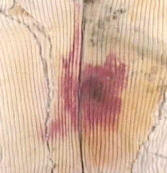

Below
are the results of three Griess Tests standards, made at 3, 12, and 18
inches. By comparing the Griess Test results from the evidence to
the standards you can see that the 3-inch standard shows a nitrite
deposit considerably more concentrated and smaller in diameter than the
evidence pattern. In addition, the 18-inch Griess Test standard shows a
broader and less concentrated pattern than that seen on the evidence
pattern. The 12-inch Griess Test standard is very similar to that
seen on the evidence pattern.
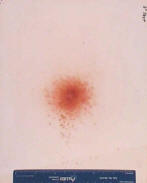
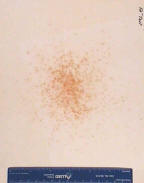
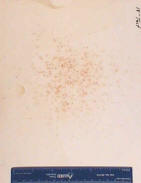
The
muzzle-to-garment distance would then be reported as greater than 3
inches but less than 18 inches.
To somewhat confirm what the
Griess Test results have shown the lead residue deposits on the
evidence will be compared to the lead residues found on the
standards.
Below
are the actual target standards showing the lead residues present.
Again, the lead residues seen on the 3-inch target (left) are more compact and
concentrated than those seen on the evidence shirt. This confirms
the 3-inch minimum distance. The 18-inch standard (right) shows
very little lead residue and again confirms the maximum
muzzle-to-garment distance. The 12-inch standard (middle) seems a
little less concentrated than the lead deposit seen on the evidence
shirt.
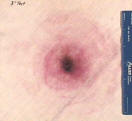
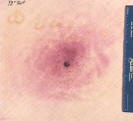
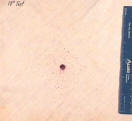
When a
firearm is not recovered there still may be certain general conclusions
that can be reached when gunshot residues are found on the evidence
garment.
Probably the easiest conclusion to report would be one involving a
contact or near contact gunshot. The results may read something
like:
Exhibit
1 (shirt) was found to have a bullet entrance hole in the chest area
that displays physical effects and gunshot residues consistent with a
contact or near contact gunshot.
A contact or near contact gunshot
will normally deposit a very intense ring of residue right around
the margins of the bullet hole.
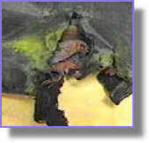
Higher velocity firearms can rip and tear
clothing, like that seen in the image above, and the heat and flame from the burning gunpowder can melt synthetic fibers.
Another conclusion that is fairly easy to reach involves what can be
call a close range gunshot. The results may read
something like:
Exhibit
1 (shirt) was found to have a bullet entrance hole in the chest
area. A heavy deposit of gunshot residues were found around this
hole that are consistent with those that would be deposited by a close
range gunshot.
Close range gunshots will usually
leave a very concentrated deposit of residue around the bullet
entrance hole that is visible to the eye.
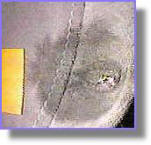
A close range gunshot,
like the one seen above, will typically be in the near contact to approximately 12-inch range of fire.
An intermediate range gunshot usually will deposit a significant amount of
particulate residue that is not easily seen with the eye but can be detected through a
microscopic examination and through chemical testing. The results may
read something like:
Exhibit
1 (shirt) was found to have a bullet entrance hole in the chest
area. A deposit of gunshot residues were found around this hole
that are consistent with those that would be deposited by an
intermediate range gunshot.
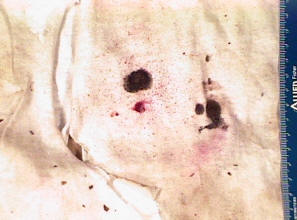
An intermediate range gunshot,
like that seen in the above image, can range from just beyond the 12-inch range out to 24 to 36 inches. This depends greatly
upon the caliber, barrel length and powder type used in the ammunition.
When
no residues are found around a bullet hole, it can mean several
things.
-
The firearm
was at a distance far enough away that the residues did not reach the garment.
-
An intervening object
between the firearm and garment preventing the residues from
reaching the garment.
-
Gunshot residues were removed through severe handling, heavy bleeding,
or by some other means.
There will also be times when
only trace deposits of gunshot residues are found. Trace
amounts of gunshot residues can come from any number of sources.
Prior handling or firing of a firearm or being near a firearm that
was discharged are just a couple possible sources.
When
firearm examiners are presented with any one of these situations, they will generally report that no
muzzle-to-target distance could be determined.
|